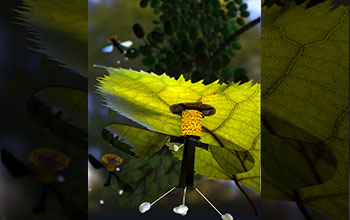Multimedia Gallery
RoboBee uses static electricity to land and stick to surfaces
Developed by Harvard University roboticists, RoboBee uses electrostatic adhesion -- the same basic science that causes a static-charged sock to cling to a pant leg -- to perch during flight.
More about this image
Finding inspiration from nature, roboticists at Harvard University's Microrobotics Lab have created RoboBees, flying microrobots that can perch during flight to save energy, just like bats, birds or butterflies.
"Many applications for small drones require them to stay in the air for extended periods," said Moritz Graule, first author of a paper published about the research, which he conducted as a student at the Harvard John A. Paulson School of Engineering and Applied Sciences (SEAS) and Wyss Institute for Biologically Inspired Engineering at Harvard. "Unfortunately, smaller drones run out of energy quickly. We want to keep them aloft longer without requiring too much additional energy."
Animals perch to conserve energy, but the methods they use to do so -- like sticky adhesives or grasping with talons -- are not appropriate for a paperclip-sized microrobot, which either require intricate systems with moving parts or high forces for detachment.
RoboBee uses an electrode patch and a foam mount that absorbs shock. The robot takes off and flies normally but when the electrode patch is supplied with a charge, it can stick to almost any surface. The patch requires about 1000 times less power to perch than it does to hover, offering to dramatically extend the operational life of the robot.
The research was funded by National Science Foundation grant CMMI 1251729.
Read more about this research in the Science story Perching and takeoff of a robotic insect on overhangs using switchable electrostatic adhesion; or see the Harvard news story Using static electricity, RoboBees can land and stick to surfaces. (Date image taken: unknown; date originally posted to NSF Multimedia Gallery: Feb. 14, 2017)
Credit: Harvard Paulson School of Engineering and Applied Sciences
Images and other media in the National Science Foundation Multimedia Gallery are available for use in print and electronic material by NSF employees, members of the media, university staff, teachers and the general public. All media in the gallery are intended for personal, educational and nonprofit/non-commercial use only.
Images credited to the National Science Foundation, a federal agency, are in the public domain. The images were created by employees of the United States Government as part of their official duties or prepared by contractors as "works for hire" for NSF. You may freely use NSF-credited images and, at your discretion, credit NSF with a "Courtesy: National Science Foundation" notation.
Additional information about general usage can be found in Conditions.
Also Available:
Download the high-resolution JPG version of the image. (4.2 MB)
Use your mouse to right-click (Mac users may need to Ctrl-click) the link above and choose the option that will save the file or target to your computer.

 All images in this series
All images in this series